

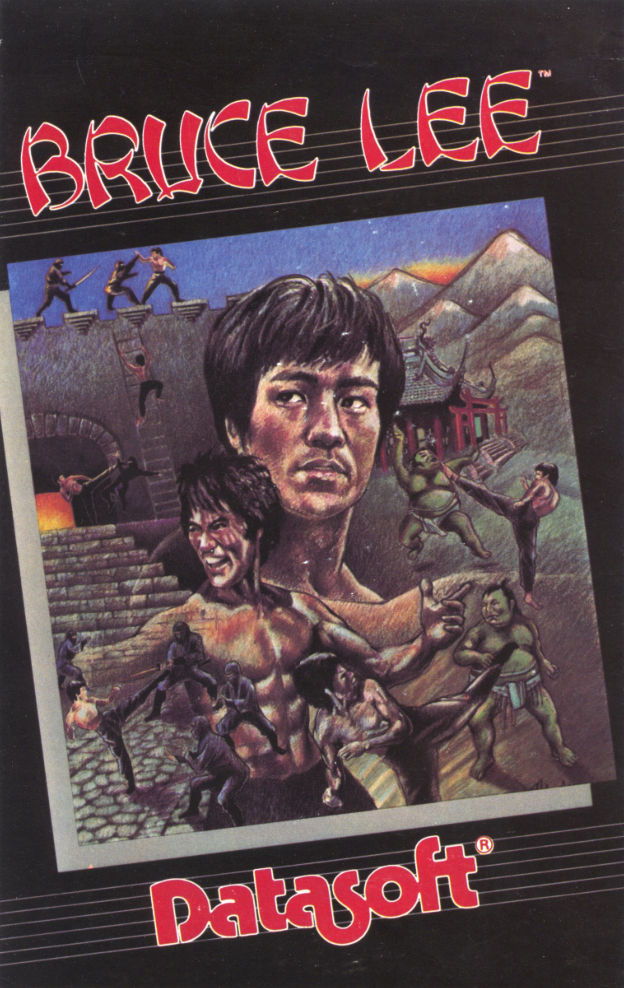
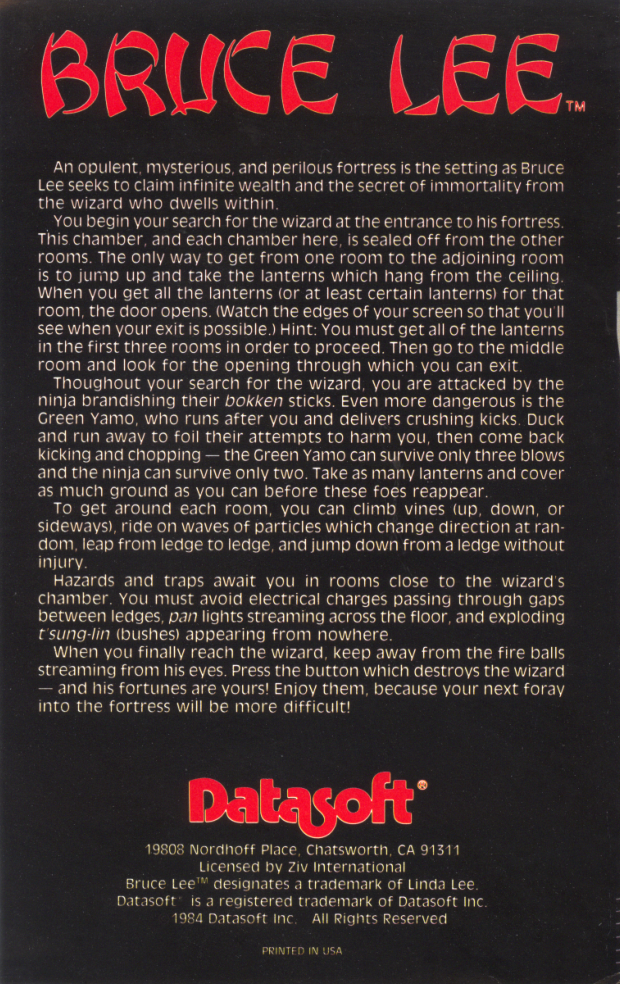
In what is considered the first ever platforming beat'em up, our eponymous hero fights his way through the mysterious and perilous fortress in an epic quest to overthrow the evil Wizard, claim infinite wealth and the secret of immortality.
Ron J. Fortier, a programmer in the Chatham, California based software company Datasoft, Inc. had just finished converting Sega's Zaxxon to the Atari 400/800, to critical acclaim. While waiting for his next assignment, he continued his research on the inner workings of the Atari by tinkering with a platforming game engine.
 Ron J. Fortier in his office, 1984
Ron J. Fortier in his office, 1984
It turned out that the licence secured by DataSoft would be a game starring the legendary martial artist, actor and—most importantly—the 1958 Hong Kong Cha-Cha champion: Bruce Lee.
The deal was put together with the Bruce Lee estate and Ziv International by CEO Pat Ketchum and Director of Business Development, Steve Bloom.
Officially announced in May 1983, 2 the deal was a ‘character licence.’ For Bruce Lee, this meant a $5,000 advance (equivalent to $15,000 today) and 6% royalties towards the rightsholders. 5
The team now had to find a direction they wanted to take the game.
‘Let's face it,’ admitted Fortier at the time, ‘The whole Bruce Lee phenomenon was pretty much dead at the time - no morbid pun intended,’ he quickly added.
Perhaps with the benefit of hindsight, in a 2015 interview with Retro Gamer Magazine, Fortier remembers, ‘It was later that the core essence of what I was creating became the game known as Bruce Lee. We knew it would be big. There were great licences that you could dig your teeth into, and none were better than Bruce Lee. It obviously had name recognition, but it also set an expectation for the gameplay.’ 10
The team watched all the Bruce Lee movies, as well as other martial arts films on videotape to seek inspiration and true enlightenment.
Mitch Junkins, Director of Marketing at DataSoft at the time, adds that in order to create the proper spiritual deportment for creating such a game, the team also ‘ate a lot of sushi.’
Before 1983, the programmer did everything on the games. But after some consideration about it's business model, where even a book publishing model was considered, DataSoft decided to lean towards more of a ‘movie studio’ style operation, which meant that dedicated artists were now essential.
Fortier: ‘We had just started to use graphics editors at DataSoft around the time we started Bruce Lee. Prior to that point, programmers did graphics by hand.’
Ron's next-cubicle neighbour and fellow Software Development Manager, John Butrovich: ‘That change in work profile meant people and team management had to introduced into the company. Was the programmer the boss of the artist? Who had final say? These rough spots led to some inventive techniques.’ 4
But it was evident to the team that Ron's platforming experimentation would have to come into play.
Fortier: ‘The three core game mechanics were fairly obvious: platform exploration, timing and fighting. We had this idea of utilizing really fantastic graphics to create a sort of computer-movie with the player as character. We wanted the animation in particular to be outstanding.’
Graphics artist and co-designer Kelly Day read extensively on Asian architecture and attempted to integrate the visual effects he saw in the movies.
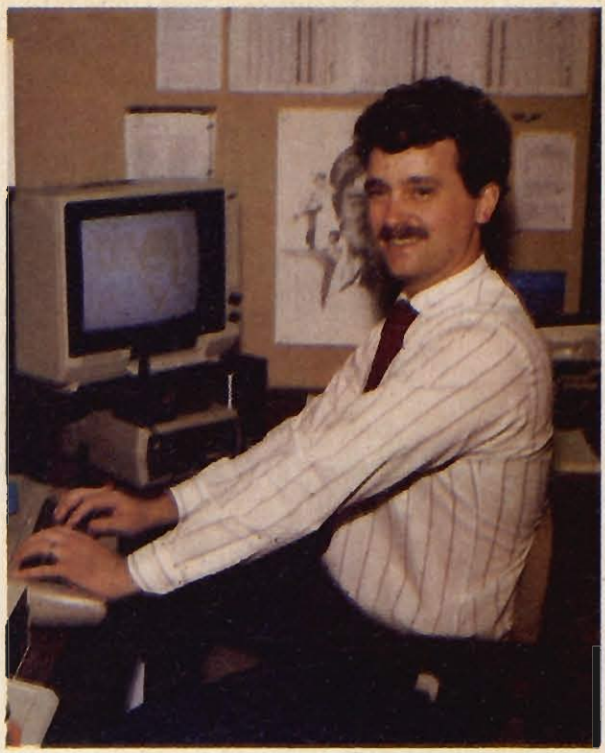 Kelly Day in his office, 1984
Kelly Day in his office, 1984
‘Kelly was a master artist that understood the limitations of the systems and how to exploit them for visuals,’ adds Fortier.
Guarding the Wizard's fortress is the large, green sumo-wrestler Yamo and his sidekick, the nameless black Ninja. Yamo can punch and throw devastating flying kicks, while the Ninja delivers blows using his ‘Bokken stick.’
However, Bruce can often outmaneuver his foes by a timely duck or jump that sometimes even causes them to fight eachother! So much for teamwork.
Fortier: ‘A two-player game was impossible, but playing one of the non-player characters and foiling your friend was not. It was easy to hook up the non-player characters to the joysticks.’
And the game indeed sports a multiplayer option, either by taking turns as Bruce - with separate scoring - or having a friend control the Green Yamo. Ah yes, the memories of Being Yamo, standing on a ledge biding his time waiting for Bruce to come around, then swiftly delivering a well-timed blow that tumbled him to his death was immensely satisfying.
Kelly Day recalls, ‘Some of the best things in this game just... happened! We had gotten all of Bruce Lee's moves down and Ron was just sort of playing around, using a joystick to control the Green Yamo...’
A fun two-player strategy was for Bruce and Yamo teaming up on the weaker Ninja, thus helping the hero to more easily complete his adventure. And a sneaky way for single players to circumvent the anti-cheating mechanism was to start a two player game and weighing down the fire button on the second joystick. Yamo would just stand there endlessly punching without posing much of a threat. 1
The fortress which Bruce must traverse consists of 20 chambers. It's riddled with deadly traps and hazards such as spikes, electrical charges, switching platforms, rolling vines, floor lights, and exploding ‘T'sung-lin’ bushes.
Fortier: ‘Every designer wants a varying level of difficulty in their games. You don't want someone to run through it, and you don't want to frustrate someone. The key for Bruce Lee was to get it dialled in at the right rates. I, luckily, had a development system that allowed me to assemble my code and test rapidly.’
One of the primary factors for it's longevity, in this writer's humble opinion, is that the difficulty level is relaxed a bit compared to contemporary games. Even though there are some accurate timing and reflexes required, the game never feels too hard to master, even for novice players.
Fortier, on the other hand, had one regret about the difficulty level: ‘Pat Ketchum was president and he had problems playing the game, so he had me dial it back a bit. Given the choice I would have gone with the second to last settings as I felt they were perfect.’
In development, the game was assembled on an Apple II, then beamed into a slave Atari for testing. This allowed for quick turnaround from coding to testing.
Mitch Junkins remembers, ‘We had weekly updates with Ron and the other programmers to look at the gameplay and discuss completion.’—‘I always had to bribe them with donuts to get them to come to the meetings,’ he laughs.
Eight months after starting development, the Atari version of the game was ready for the US market in April 1984, with a suggested retail price of $34,95 (a hefty $106 today!) for the disk version. The Apple II version, programmed by Rick Mirsky, was announced in May 1984. 12 PC and PCjr versions, programmed by Sheng-Chung Liu, was announced in November 1984. 13 The Commodore 64 version was handled by Ron himself, and was available in October 1984, in time for the upcoming and lucrative Christmas season. 14
Fortier recalls, ‘The first conversion was to the C64. As I had increased RAM and 25 per cent more CPU speed, I decided to write an Atari emulator. Apple, PC and PCjr were in-house, so I was able to work with the programmers.’ 2
The iconic music and sound effects for the C64 version was created by John A. Fitzpatrick, a contractor who also provided sound for other DataSoft games such as Conan, The Goonies, Mancopter, and Mr. Do!
John Butrovich: ‘Datasoft never had an in-house sound person. All the sound guys we used were contractors, they had all the necessary tools and facilities.’
DataSoft contracted out the ports to Amstrad CPC, BBC Micro, FM-7, MSX, NEC PC-88, Sharp MZ-800, Enterprise 64/128 and the ZX Spectrum to external developers.
Fortier: ‘You really couldn't say much about the Spectrum as I just remember it blinking a lot. The MSX was fun, but working internationally was challenging at the time so our team couldn't help that much on quality.’
The end of year issue of the Danish magazine Soft, mentions the Enterprise 64/128 home computer version, liberally translated:
There was a lof of news on the Enterprise stand, including a lot from US Gold. ‘Raid over Moscow,’ ‘Beach-Head,’ and more. But then it got too much, because the US Gold version of ‘Bruce Lee’ had been rejected by the Enterprise people as ‘too low quality.’ Kempf from Enterprise said the graphics was not up to par with what the Enterprise could deliver. 15
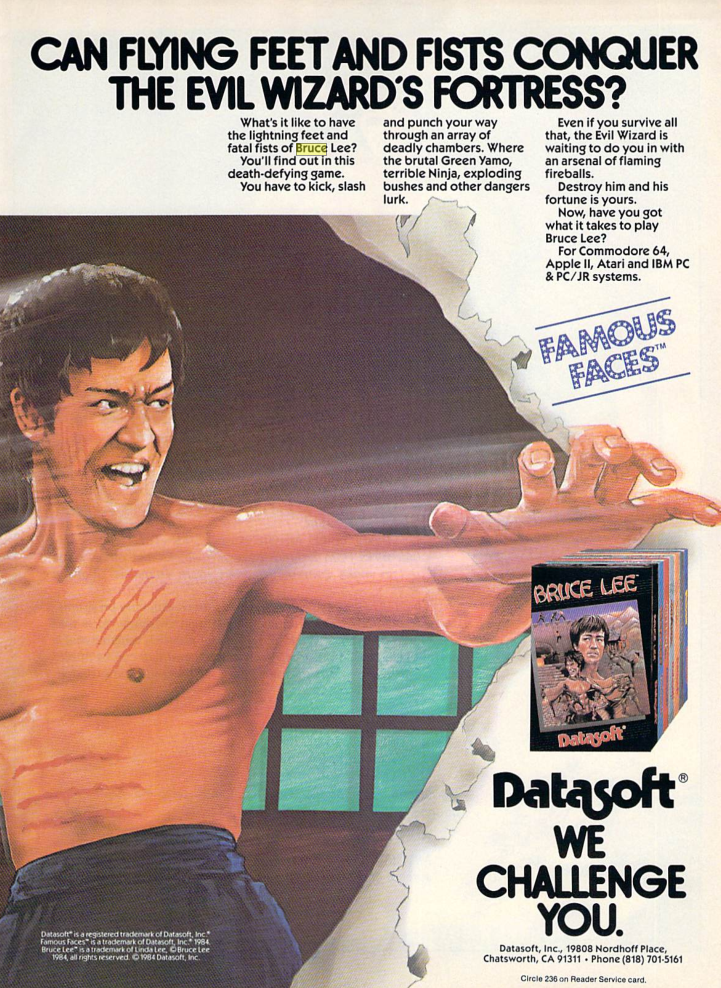 This was used in many magazines in 1984.
This was used in many magazines in 1984.
The game was generally well-received, with some scepticism about yet another celebrity game tie-in put to shame.
Somehow a copy ended up in the hands of Steve Marano, author of the Micro of Monmouth Atari enthusiast's newsletter as early as April 1984:
[...] In summary, the combination of excellent graphics and playability as provided by Ron Fortier with a thoughtful packaging policy as practiced by DataSoft results in a thoroughly enjoyable game. I wholeheartedly recommend BRUCE LEE. 3
Of the bigger publications, David P. Stone reviewed the game in the June 1984 issue of Computer Gaming World:
I don't know what ‘martial arts’ is, but I know what I like. And, I like Bruce Lee. It delivers all the foot kicking, fist jabbing, quick ducking action-packed adventure you'd expected from a good grade B, martial arts movie. 4
Fortier: ‘I was blown away by it's success. While it pales in comparison to today's dollars, I think we had a higher percentage of the installed base. It was one of those games that everyone had.’
In June of 1984, Gillette—yes, the razor blade company—decided they wanted to get into the entertainment business, and aquired a 40% stake in DataSoft. Pat Ketchum had some corporate bingo lingo handy:
‘The new affiliation with Gillette will enable DataSoft to continue its strong growth trend by introducing new products with widespread consumer appeal.’ 9
After Bruce Lee, Ron J. Fortier's next project would be the Atari and C64 versions of another character licence, Conan - The Halls of Volta (1985), followed by his final 8-bit project, the C64 conversion of Alternate Reality: The City (1986). Before it was finished, however, he decided to move on to Epyx for a Project Manager role.
Eventually Gillette decided to get out of the entertainment business. Funding was pulled, and DataSoft was forced to file for bankruptcy in September 1985. 5
The company was put up for auction. Thinking that the Alternate Reality concept had potential, DataSoft business executives Samuel L. Poole and Ted Hoffman put in a winning bid under a new company called IntelliCreations. 3
One of the losing bidders was the original founder and CEO, Pat Ketchum.
Curiously, while IntelliCreations set up shop, Gillette continued to fund the development of Alternate Reality. Programmer Ken Jordan (The Neverending Story (C64), Alternate Reality) remembers:
Its interesting that before Sam and Ted actually got the new company started, the Gillette razor company (who was a major investor in DataSoft) actually paid Jim Ratcliff and myself directly for a few months to keep work on the AR City Apple ][ and C-64 ports progressing (the checks we were paid with actually came from the Jafra cosmetics company - kind of strange we thought.) 6
In 1986, some speculation about a Bruce Lee sequel would surface when the new DataSoft/IntelliCreations CEO Sam Poole revealed in an interview concerning Alternate Reality:
Obviously as we're designing and developing the [Alternate Reality] series, we've learned a great deal about random character generation, and logic and statistics. As a result, we're now looking to use some of those same types of features in a follow up program based on Bruce Lee, which has been a major seller in Europe.
Called Bruce Lee - Enter the Dragon, it will be a full roleplaying adventure and have strong hi-res graphics and animation sequences, but taking advantages of some of the techniques we've developed in [Alternate Reality]. Combining the best of both. 7
But in 2022, Fortier responded to the fact that there never actually was an official sequel, hinting at cash-flow problems in DataSoft:
That is correct. I and others did want to start on a sequel immediately after finishing the original, but management at DataSoft wouldn't green-light the project / cash. 8
Asked about the sequel, Mitch Junkins weighs in: ‘I don't know how it [Bruce Lee] performed against our royalty guarantees, but that usually drives the business decision. I believe the license was one and done.’
John Butrovic, still in DataSoft at the time, has no memory of a sequel and was surprised to hear of it.
But as Pat Ketchum kindly pointed out: DataSoft did have a three-year exclusive deal for the Bruce Lee on all platforms, with the option of renewing it by paying another advance before the licence expired. So DataSoft in 1986 plausibly had the option to renew the licence, given demand. 5
John Butrovich: ‘That [IntelliCreations] worked until Electronics Arts (our distributor) changed their return policy and the company felt a cash crunch.’
The new DataSoft was again in finanical peril and as such had to look for suitors.
It was finally announced—in August 1988—that Software Toolworks had aquired IntelliCreations. 10 Ken Jordan dryly remarks: ‘Mainly to get our office buildings and warehouse, it seemed.’ 6
Interestingly, in 1989, Software Toolworks published a game starring our favourite Cha-Cha champion, Bruce Lee Lives, for DOS.
Unless IntelliCreations renewed the licence before it expired in 1986—without taking advantage of it—it's most likely that this game was based on a new licence with the rightsholders. The game does give special thanks to Linda Lee, the widow of Bruce and proprietor of the estate.
This is, of course, only speculation on my part.
The game continues to inspire hobby game developers around the world — including myself — to create new games set in the Bruce Lee universe.
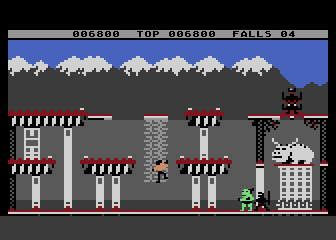 |
Atari 800 XL | Ron J. Fortier, Kelly Day | 1984 DataSoft Inc. (Apr) | Video |
 |
Commodore 64 | Ron J. Fortier, Kelly Day, John A. Fitzpatrick | 1984 US Gold (Oct) | Video |
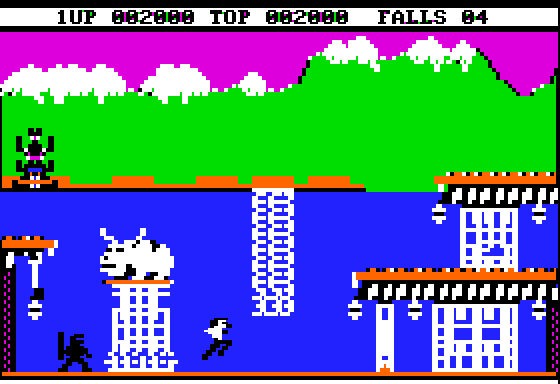 |
Apple II | Rick Mirsky, Kelly Day | 1984 DataSoft Inc. (May) | Video |
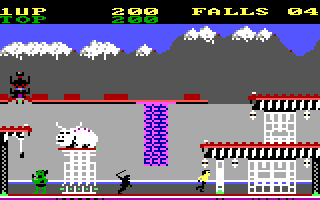 |
PCjr. / DOS | Sheng-Chung Liu, Kelly Day | 1984 DataSoft Inc. (Nov) |
PCjr Video DOS Video |
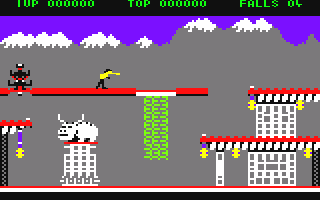 |
Amstrad CPC | Timedata Ltd. | 1984 US Gold |
Video |
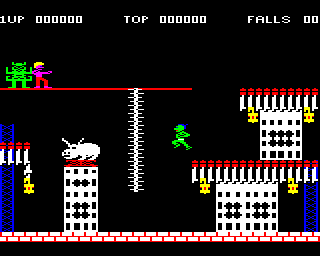 |
BBC Micro | D. Cowham | 1984 Micro Power Ltd. |
Video |
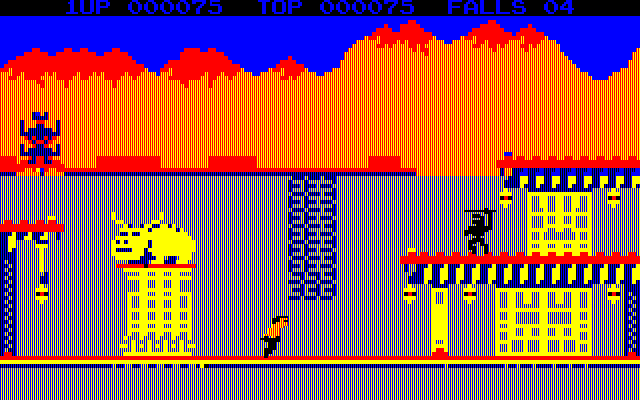 |
FM-7 | Mitani Matsuda | 1984 Comptiq (Sep) |
Video |
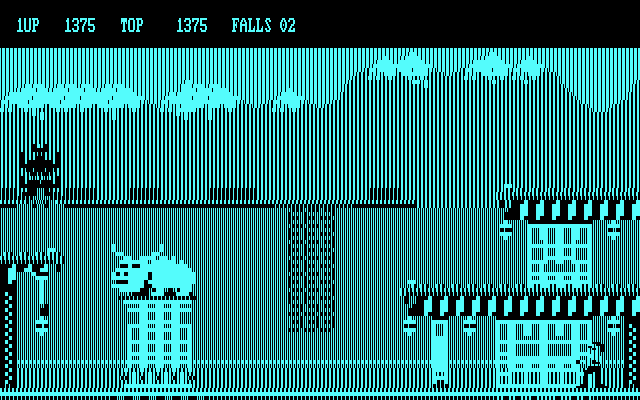 |
NEC PC-88 | 1984 Comptiq (Oct) |
Video |
|
 |
ZX Spectrum | L.T. Software | 1985 Ocean |
Video |
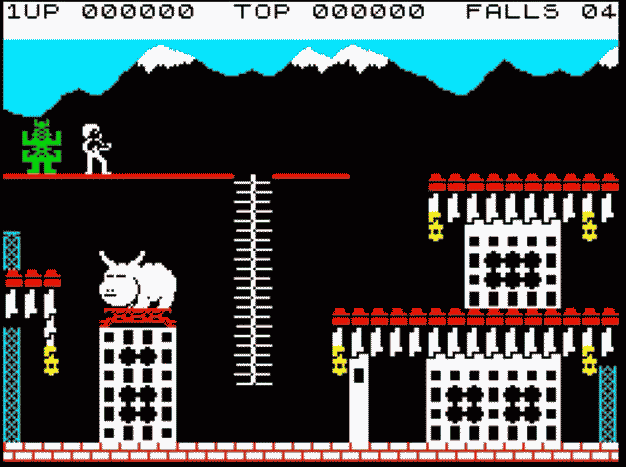
|
Enterprise 64/128 | L.T. Software (probably) | 1985 Ocean |
Video |
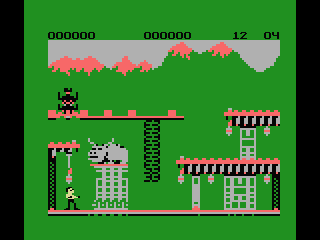 |
MSX | Mike Livesay | 1985 Comptiq (Dec) |
Video |
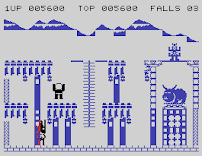 |
Sharp MZ-800 | J.O. | 1988 Vsetin (Apr) |
Video |
| Time | Publication | Country | System | Rating | Archive.org |
|---|---|---|---|---|---|
| April 1984 | Micro of Monmouth | US | Atari | Recommended | Vol.3 Issue 4 |
| April 1984 | Atari Computer Enthusiasts | US | Atari | Favourable | Issue 04 |
| April 1984 | Computer Entertainer | US | Atari | Favourable | Issue 03 |
| May 1984 | WACE NZ | NZ | Atari | Favourable | Issue 17 |
| June 1984 | Analog Computing | US | Atari | Favourable | Issue 19 |
| June 1984 | Computer Gaming World | US | Atari |
Getting started: 7
Graphics: 9
Value: 7
Playability: 7
|
Issue 4.3 |
| July 1984 | Happy Computer | DE | Atari |
Favourable
|
Issue 07 |
| July 1984 | K-Power | US | Atari |
Graphics: 4/5
Excitement: 4/5
Originality: 5/5
Ease of use: 5/5
Challenge: 4/5
Shelf life: 3/5
|
Issue 06 |
| July 1984 | Personal Computer News | UK | Atari |
Lasting appeal: 4/5
Playability: 5/5
Use of Machine: 5/5
Overall value: 5/5
|
Issue 70 |
| August 1984 | Computer & Video Games | UK | Atari |
Getting started: 7
Graphics: 9
Value: 7
Playability: 9
|
Issue 34 |
| September 1984 | Electronic Games | US | Atari |
Favourable
|
Issue 14 Vol. 2 |
| September 1984 | Enter | US | (Atari) |
Favourable
|
Sept. 1984 |
| September 1984 | Joystick | Sweden | Atari |
Value: 4/5
Graphics: 4/5
|
Issue 05 |
| September 1984 | Personal Computer World | UK | Atari | Favourable | Issue 09 |
| November 1984 | TV Gamer | US | Atari |
Value: 4.5
Graphics: 4.5
Sound: 3
Gameplay: 4.5
|
Issue 11 |
| December 1984 | Personal Computer Games | UK | (C64) |
Graphics: 8
Sound: 5
Originality: 8
Lasting interest: 8
Overall: 8
|
Issue 13 |
| December 1984 | Votre Ordinateur 10 | France | Atari | Favourable | Issue 10 |
| December 1984 | Micro 7 | France | Multiple | Favourable | Issue 22 |
| January 1985 | Antic Magazine | US | Atari | Favourable | Issue 09 Vol. 3 |
| January 1985 | Commodore Computing International | UK | C64 |
Graphics: 5 stars
Sound: 4 stars
Playability: 4 stars
CCI Rating: 5 stars
|
Issue 07 Vol. 3 |
| January 1985 | Commodore Horizons | UK | C64 |
Graphics: 6 stars
Sonics: 6 stars
Gameplay: 6 stars
|
Issue 13 |
| January 1985 | Commodore User | UK | C64 |
Presentation: 5/5
Skill level: 3/5
Interest: 3/5
Value for money: 4/5
|
Issue 16 |
| January 1985 | HC Home Computer | Italy | Atari | No rating | Issue 09 |
| January 1985 | Home Computing Weekly | UK | C64 |
Instructions: 85%
Graphics: 90%
Playability: 90%
Value for money: 80%
|
Issue 95 |
| February 1985 | Big K | UK | C64 |
Graphics: 3 K's
Playability: 3 K's
Addictiveness: 3 K's
|
Issue 11 |
| March/April 1985 | Popular Computing Weekly | UK | ZX Spectrum / C64 |
Recommended
|
Issue 28 Vol. 3 |
| April 1985 | L'Atarien | France | Atari | TBD | Issue 07 |
| March 1985 | Page 6 | UK | Atari | Favourable | Issue 14 |
| March 1985 | Your 64 | UK | C64 | 3 of 5 stars | Issue 07 |
| May 1985 | A Tutto Commodore | Italy | C64 | No rating | Issue 05 |
| May 1985 | Computer & Video Games | UK | ZX Spectrum |
Graphics: 9
Sound: 8
Value: 9
Playability: 9
|
Issue 43 |
| May 1985 | Crash Magazine | UK | ZX Spectrum |
Use of computer: 85%
Graphics: 90%
Playability: 89%
Getting started: 80%
Addictive qualities: 92%
Value for money: 85%
Overall: 91%
|
Issue 16 |
| May 1985 | Sinclair User | UK | ZX Spectrum | 4 of 5 stars | Issue 38 |
| May 1985 | Sinclair Programs | UK | ZX Spectrum | 75% | Issue 31 |
| May 1985 | Hardcore Computist | US | Apple | Favourable | Issue 19 |
| May 1985 | Your Spectrum | UK | ZX Spectrum |
Dave: 3½/5
Ross: 2/5
Roger: 2/5
|
Issue 14 |
| June 1985 | Bits & Bytes | New Zealand | C64 | Favourable | Issue 09 Vol. 3 |
| June 1985 | ZX Computing Magazine | UK | ZX Spectrum | Gaphics: 4 stars
Addictivity: 4 stars
Overall: 4 stars
| Issue 06 |
| July 1985 | Commodore Magazine | Italy | C64 | Recommended | View |
| December 1985 | MSX Magazine | Japan | MSX | Favourable | Issue 28 |
| January 1986 | Amstrad Computer User | UK | Amstrad |
Graphics: 17
Sound: 14
Polish: 15
First impression: 16
Lasting impression: 18
Value: 18
|
Issue 14 |
| January 1986 | Amtix | UK | Amstrad |
Presentation: 83%
Graphics: 88%
Sound: 79%
Playability: 94%
Addictive Qualities: 95%
Value for Money: 89%
Overall: 93%
|
Issue 03 |
| March 1986 | Amstrad Computer User | UK | Amstrad |
Graphics: 17
Sound: 14
Polish: 15
First impression: 16
Lasting impression: 18
Value: 18
|
Issue 14 |
| March 1986 | CPC Schneider International | Germany | Amstrad |
Idea: 4/10
Playability: 7/10
Documentation: 6/10
Graphics: 9/10
Sound: 7/10
Price: 10/10
|
Issue 13 |
| July/August 1988 | SOFT | Denmark | C64 |
4/5 stars
|
Issue 04 Vol. 4 |
| August 1988 | Zzap! 64 | UK | C64 |
Presentation: 83#
Graphics: 54%
Sound: 49%
Hookability: 91%
Lastability: 95%
Overall: 92%
|
Issue 40 |
| March 1989 | MSX Club | Spain | MSX |
First minute: 7/10
First hour: 6/10
First day: 6/10
After a week: 5/10
After a month: 5/10
After a year: 5/10
|
Issue 50 |
| December 1990 | Your Commodore | UK | C64 |
Graphics: 40
Sound: 60
Brains: 60
Overall: 75
|
Issue 74 |
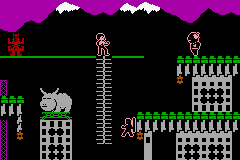 |
Gameboy Advance | Jim Bagley | 2003 Jim Bagley | Website |
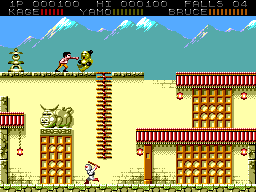 |
Sega Master System | Kagesan | 2015 Kagesan | |
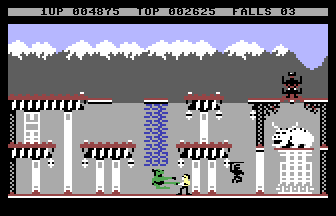 |
Commodore Plus4 | Sasvári, Tamás (TCFS), Tettinger, Tamás (Chronos), Pankaczy, Csaba (Csabo) | 2022 Psytronik |
Video Plus4World |
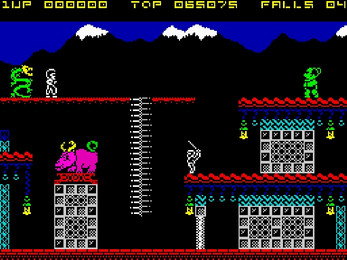 |
ZX Spectrum | Highriser | 2019 Highriser | Itch.io |
 |
Atari 2600 | Spendidnut, IanAjax | 2023- Work-in-progress |
 |
Karate King | Memotech MTX500 | Mike Bayne, Chris Bayne | 1985 Megastar Games Inc. | Video |
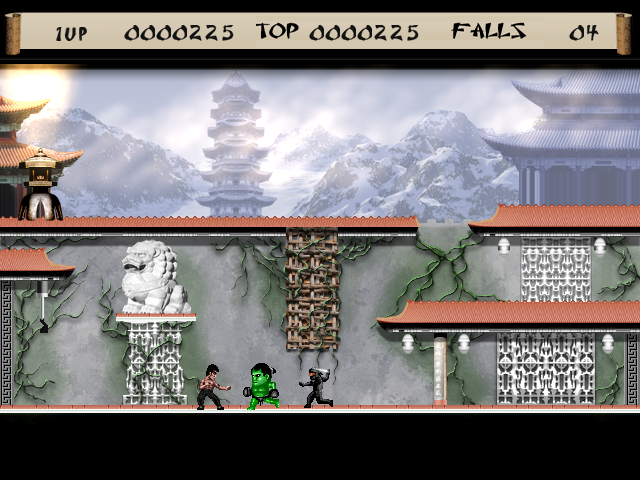
|
Ultimate Bruce Lee | Windows | Stu Collier, Smila Storey, Infamous | 2005 Stu and Smila | |
 |
Bruce Lee II | Windows | Bruno R. Marcos | 2013 Bruneras.com | |
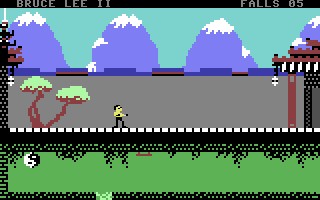 |
Bruce Lee II | Commodore 64 | Jonas Hultén | 2015 Kollektivet.nu | |
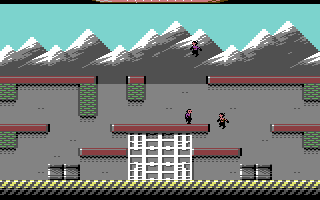
|
Tiger Claw | Commodore 64 | Matthias Bock (LazyCow), Saul Cross | 2016 RGCD | |
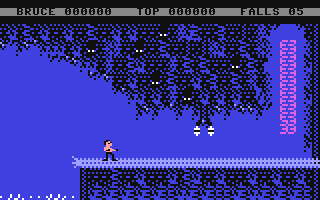
|
Return of Fury | Commodore 64 | Vidar Bang (dmx), FlowTnT, TIX | 2019 Rebel Android | |
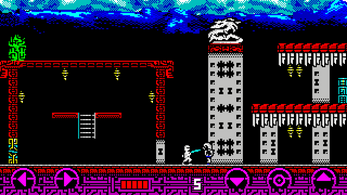
|
Kung-Fu Bruce | Windows | Stephen Tomcat | 2019 Stephen Tomcat | |
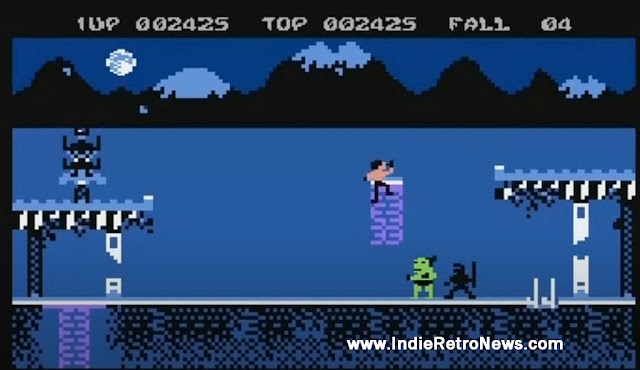
|
Return of Fury | Atari XL/XE | Ute, Fantomas, TIX, dmx | 2022 | Video |
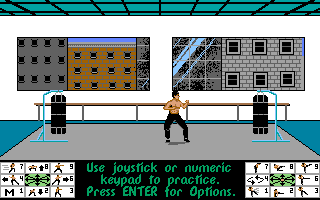 |
Bruce Lee Lives | DOS | 1 vs 1 fighting | 1989 Software Toolworks, Inc. | MobyGames |
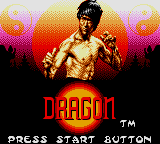 |
Dragon: The Bruce Lee Story | GameGear, SNES, Genesis, Jaguar, Master System | Platformer | 1993-1995 Acclaim / Virgin Interactive | |
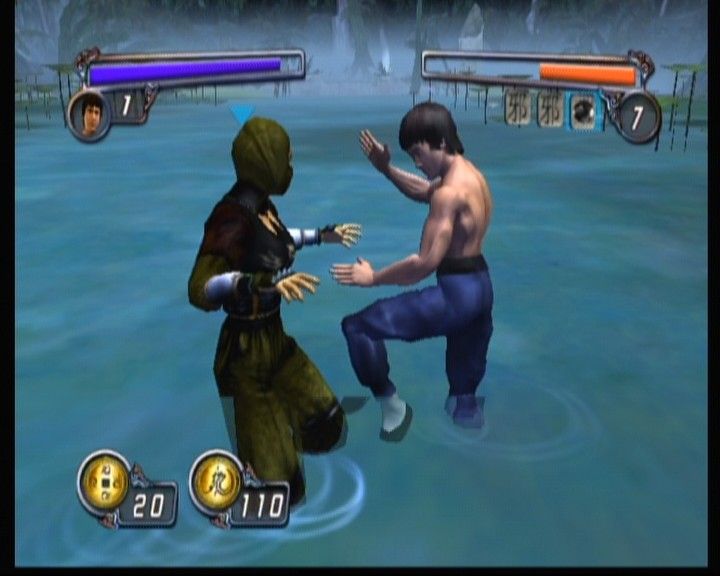 |
Bruce Lee: Quest of the Dragon | XBOX | Third-person fighting | 2002 Universal / Ronin Entertainment | |
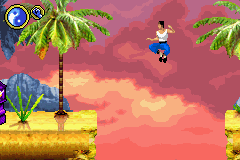 |
Bruce Lee: Return of the Legend | GameBoy Advance | Platformer | 2003 Vivendi / Vicarious Visions | |
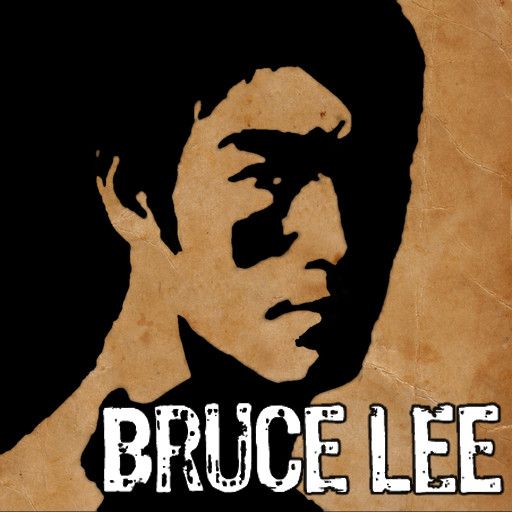 |
Bruce Lee: Dragon Warrior | iOS | 1 vs 1 fighting | 2010 Indiagames Ltd. / Digital Legends Entertainment | |
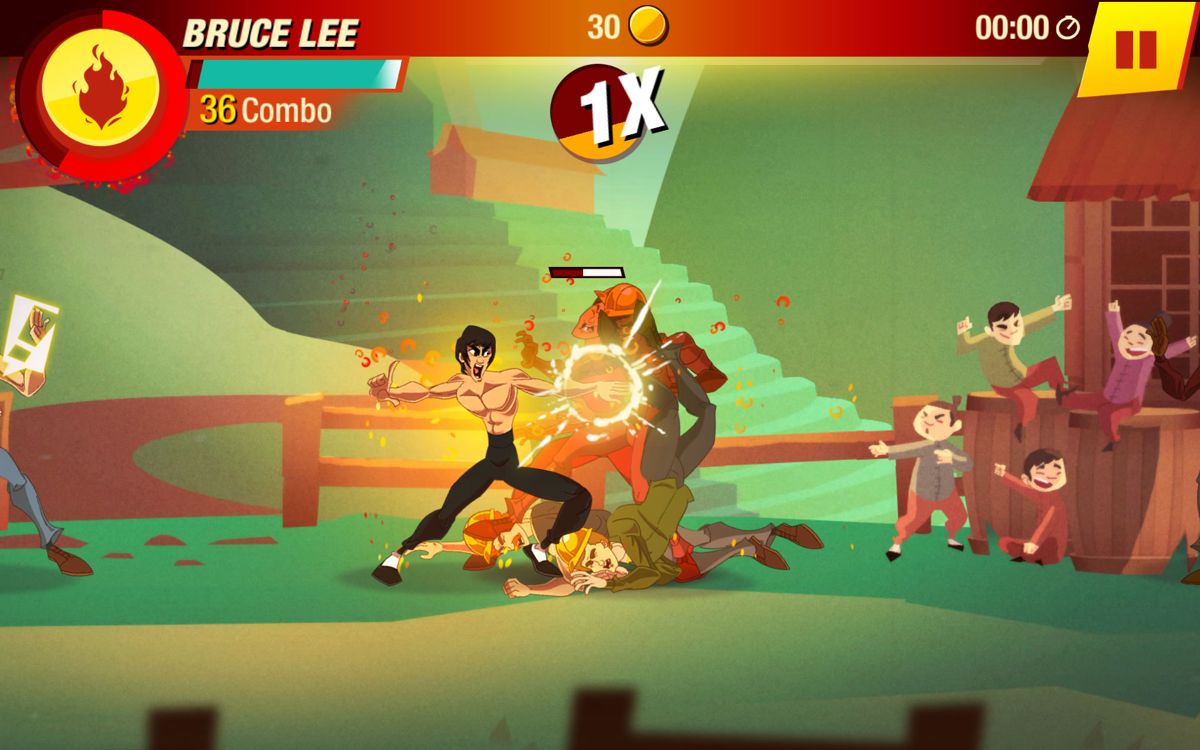 |
Bruce Lee - Enter the Game | iOS / Android | Platformer | 2014 Hibernum Créations Inc. | MobyGames |
Artist: Unknown.
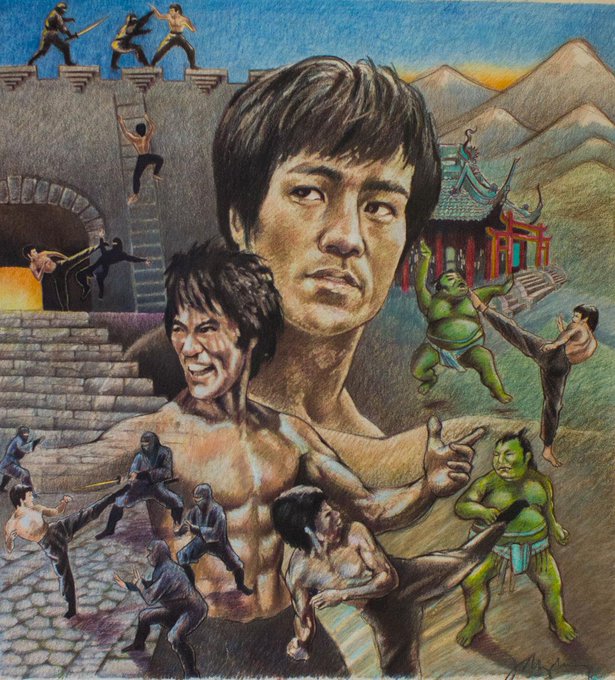
The font for the ‘Bruce Lee’ lettering used in the box and manual was sourced from Speedball textbook for pen & brush lettering, 18th edition (1960), specifically Far East Type (p. 40)
It has been reworked into digital as China Doll JNL by Jeff Levine.
An approximation of Far East Type was also used in Bruce Lee Lives (DOS, 1989)
[1] The game features an anti-cheat mechanism whereas if you start a two player game Yamo will become computer-controlled after a period of inactivity. Weighing down the button prevents this.
[2] For a while I was wondering what he meant by ‘Atari emulator’. It finally dawned on me while chatting with the cool guys doing the Atari port of Return of Fury, where I mentioned that the tile collision detection in the C64 version used tile-mask data, and they replied ‘What mask data?’ - Ah, my dear Mr. Hastings; the Atari hardware-based player-object to background collision detection was indeed emulated on the C64, cutting down on development time!
[3] The original name was H-P Software Productions, Inc. Hewlett Packard objected, and it was swiftly renamed IntelliCreations.
[4] John Butrovich: ‘When Scott Spanburg was working on The Goonies, he devised an animation method centered around "Goonie Bucks". The artist has so many GB's to spend on each screen. Whether a sprite or bitmap animation, everything was costed as an 8x8 buck. So, the artists had to live within the animation budget by managing their GB's. This was at the juncture where we were moving to using common 6502 code core between machines (Apple II, Atari 800, Commodore 64.) What the artist thought would be easy to do on the Atari wouldn't be as so on the Apple II with no graphic hardware assist. Forging ahead within the fledging industry was a learning experience for all.’
[5] I was curious about if the Bruce Lee licence was a one-and-done deal, and was so fortunate to reach Pat Ketchum, who recalls: ‘ All our character licenses were on a three year term, on all consoles and computers. This would give us a year to develop and two years to sell. An advance against royalties was always paid on signing. I think Bruce Lee was $5,000 advance (equivalent to $15,000 today). The license agreement also included a right to extend the period an equivalent period for a payment of another advance. Our license agreement for character were never limited to just one game. We could do as many as we want for each period. Royalty for character was usually 6%. ’
Interestingly, the terms were quite different for arcade licences: ‘ With arcade licenses (Mr Do, Pooyan, Dig-Dug, Pole Position, etc.) they were based on one property for the term of the agreement. We paid a royalty and an advance. Most advances were $5,000, but with Namco (Pac-Man, etc.) we paid $80,000 advance. With Frogger and Zaxxon we did a profit split. DataSoft deducted all its costs from revenues, and the net profit was split with Sega.’
[1] Electronic Games Vol. 2 No. 16 1984-11. Pages 78-79.
[2] Electronic Fun with Computer Games Vol. 1 No. 7 1983-05. Page 45.
[3] Micro of Monmouth Atari Enthusiast's Newsletter April 1984. Page 4.
[4] Computer Gaming World Volume 4.3. Page 32.
[5] Twin Cities Atari Interest Group (TAIG) 1985-09. Page 26.
[6] Alternate Reality Infrequently Asked Questions
[7] Zzap! 64 Issue 13 1986-05. Page 76.
[8] Tweet by @RonFortier from 8th July 2022
[9] Computer Gaming World Volume 4.3. Page 16.
[10] LA Times, 9th August 1988
[11] Retro Gamer Magazine Issue 145, 2015.
[12] InCider, May 1984. Page 144.
[13] PCjr. Magazine, November 1984. Page 64.
[14] csdb Saegersoft Group Crack, October 1984
[15] Soft Magazine, Nov/Dec 1985. Page 5.